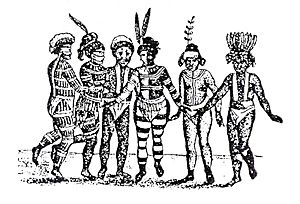Ohlone people facts for kids
The Ohlone people are a group of Native American people who have lived for thousands of years along the north and central California coast. Their traditional lands stretched from the San Francisco Bay Area down to the Big Sur coast. They are also known as the Costanoan people.
Contents
Who Are the Ohlone People?
The Ohlone are not just one single tribe. They were made up of many different groups, each with their own villages and leaders. These groups shared similar languages and ways of life. They lived in harmony with the land, using its resources wisely.
Ohlone Languages
The Ohlone people spoke several different languages. These languages are part of the Utian language family. Sadly, many of these languages are no longer spoken today. However, some modern Ohlone people are working hard to bring them back. This helps keep their culture alive.
Life Before European Contact
Before Europeans arrived in California, the Ohlone people had a rich and complex culture. They were skilled hunters, gatherers, and fishers. Their daily lives were closely connected to nature.
Food and Resources
The Ohlone people ate a wide variety of foods. Acorns were a very important food source. They would gather acorns, grind them into flour, and then leach out bitter tannins to make bread or porridge. They also hunted deer, elk, and smaller animals. Fish, shellfish, and birds from the coast and bays were also a big part of their diet. They gathered many different plants, berries, and seeds.
Homes and Villages
Ohlone villages were usually small, with about 50 to 200 people. Their homes were often cone-shaped huts. These huts were made from willow poles and covered with tule reeds or grass. Villages were often located near rivers or the coast. This gave them easy access to water and food.
Ohlone Culture and Traditions
The Ohlone people had rich spiritual beliefs. They held ceremonies and dances to honor nature and their ancestors. Storytelling was also very important. It helped pass down their history, lessons, and traditions from one generation to the next. They were also skilled craftspeople. They made beautiful baskets, tools, and ornaments.
Impact of European Missions
Life for the Ohlone people changed dramatically when Spanish missionaries arrived in California in the late 1700s. The Spanish built a series of missions along the coast.
Life at the Missions
Many Ohlone people were forced to live and work at these missions. They were taught new ways of farming and building. They also learned about the Christian religion. Life at the missions was very difficult. Many Ohlone people became sick from European diseases. Their traditional way of life was greatly disrupted.
Loss of Land and Culture
The arrival of the Spanish led to a huge loss of land for the Ohlone. Their traditional territories were taken over. Their population also decreased sharply due to disease and harsh conditions. Despite these challenges, the Ohlone people worked hard to keep their culture and identity alive.
The Ohlone People Today
Today, the Ohlone people are still a vibrant community. Many descendants of the original Ohlone groups live in the San Francisco Bay Area and beyond. They are actively working to revive their languages, traditions, and ceremonies.
Cultural Revival Efforts
Modern Ohlone communities are dedicated to preserving their heritage. They hold cultural events, teach their languages, and share their history. They also work to protect their ancestral lands and sacred sites. This helps ensure that future generations will know about their rich past.
Recognizing Ohlone Heritage
Many places in California are named after Ohlone words or villages. This helps remind everyone of the long history of the Ohlone people in the region. Their story is an important part of California's heritage.
Images for kids
-
Ohlone people painted by Louis Choris
-
Replica of Ohlone Hut in the graveyard of Mission San Francisco de Asís, San Francisco
-
Watercolor of traditional Ohlone headdresses by Louis Choris
-
Three Ohlone people in a tule boat in the San Francisco Bay, painted by Louis Choris in1816
-
Indian quarters at Mission Santa Clara de Asís
-
Isabel Meadows, considered the last fluent speaker of an Ohlone language
See also
 In Spanish: Ohlone para niños
In Spanish: Ohlone para niños










